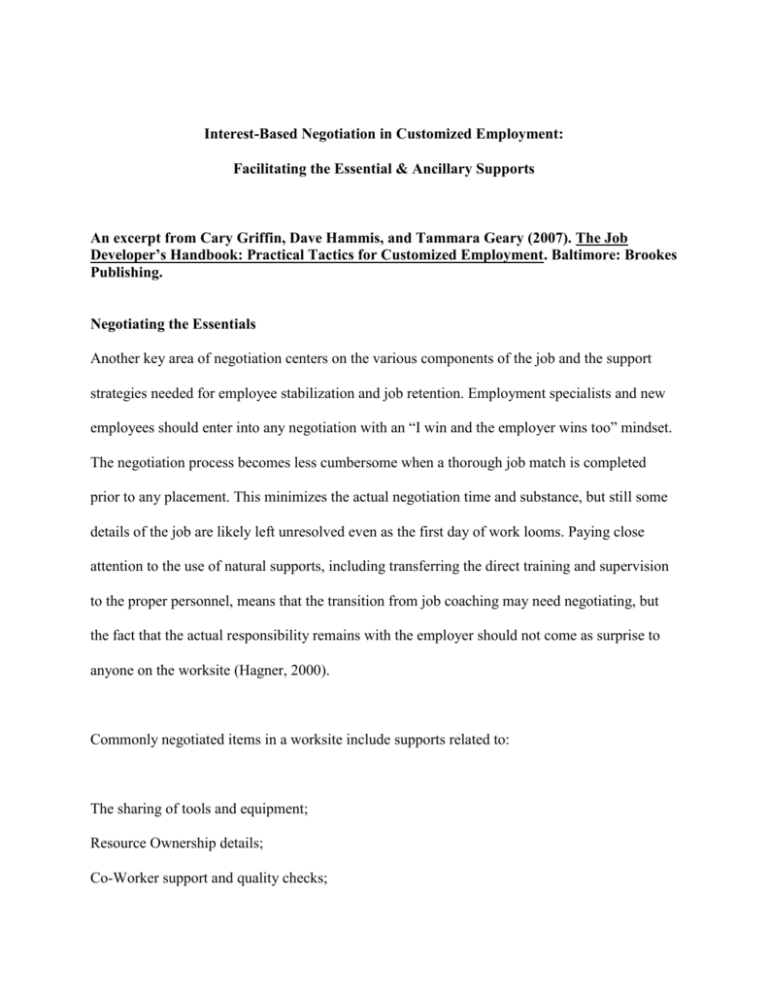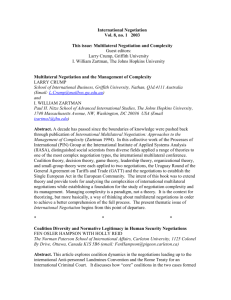Interest-Based Negotiation in Customized Employment:
advertisement

Interest-Based Negotiation in Customized Employment: Facilitating the Essential & Ancillary Supports An excerpt from Cary Griffin, Dave Hammis, and Tammara Geary (2007). The Job Developer’s Handbook: Practical Tactics for Customized Employment. Baltimore: Brookes Publishing. Negotiating the Essentials Another key area of negotiation centers on the various components of the job and the support strategies needed for employee stabilization and job retention. Employment specialists and new employees should enter into any negotiation with an “I win and the employer wins too” mindset. The negotiation process becomes less cumbersome when a thorough job match is completed prior to any placement. This minimizes the actual negotiation time and substance, but still some details of the job are likely left unresolved even as the first day of work looms. Paying close attention to the use of natural supports, including transferring the direct training and supervision to the proper personnel, means that the transition from job coaching may need negotiating, but the fact that the actual responsibility remains with the employer should not come as surprise to anyone on the worksite (Hagner, 2000). Commonly negotiated items in a worksite include supports related to: The sharing of tools and equipment; Resource Ownership details; Co-Worker support and quality checks; Supervision and quality improvement; Productivity enhancement; Templating and jigging the manufacturing process; Equipment modifications; Worksite accommodations; Personal Assistant Services on the job; Toileting and Eating assistance; Transportation, et al. Many of these work ingredients are issues faced with every employee and should be handled in as natural a means as possible (Callahan & Garner, 1997). Transportation is generally a personal responsibility, but self-organized car pools are common even in the smallest organizations. A job developer, or new employee, may need to negotiate with co-workers to share transit with a nondriving employee, or work hours may require a negotiated modification to accommodate public transportation schedules. Machine fixtures and templates are commonly employed throughout the manufacturing industry, but a truly unique adaptation may be required for some workers. Negotiating with the employer, or perhaps the plant’s engineering staff, may occur. And the expense involved may lead to a further negotiation with the employer, the Social Security Administration for a PASS, or with VR for additional tooling support. Using the most typical means and people in these circumstances stays true to the intent of natural supports theory, and engages the employer in the success of the worker. Asking for too much though, is a concern, and a position that must be so heavily modified that it stigmatizes the new employee is probably a sign that the job match was not done properly. Experience and practical application of job analysis techniques guides the proper match and an appropriate level of job accommodating negotiations. In traditional Supported Employment, employment specialists occasionally offered to complete the work of an employee, at no additional cost to the employer, who was not reaching the industry production standard, and also to substitute for the worker in event of absence. This is highly unusual and not recommended as a negotiable. Instead, the employee should retain the same considerations as other workers regarding illness and absences, and be afforded proper training and job accommodations to boost productivity. Again, if productivity is a key requirement of the job, a proper job match will screen in the correct worker. Still, many potential workers have medical or self-care concerns that, at least until they are accepted into the fabric of the company, may require specialized supports beyond the ability of the employer to provide. In such cases, worksite Personal Assistance Services (PAS) might be available, and their presence on the job site launches another negotiation episode (Unger, et al., 2002). In such a case, the employee and the employment specialist may want to spend time with the personal assistant cluing them into natural supports and a systematic fade from the worksite, to the greatest degree possible. The entire employment process is linked together by a long chain of negotiations. Maintaining a focus on the win/win aspects of the process at each step assures long-term success and that proper attention is paid to the essential stakeholders and concerns. When barriers are encountered, reframing the negotiation uncovers other options. For instance, a co-worker complains that the new employee is not mastering the use of the band saw and production is subpar. The employment specialist can offer more powerful training techniques, ask for assistance with diagnosing the problem, suggest a template, or perhaps research the cost of a more automated band saw that improves production. The important point in reframing is accepting the complaint or oppositional position, thereby validating the shared concern, then offering options for resolution. Reframing involves circumvention. Some problems are simply not easy to solve, but with a little thought can be reconfigured with a simple but elegant solution. One of the authors, for instance, was working with a major computer manufacturer at the time of the passage of the ADA. The Regional Vice President for Operations was interested in hiring people with disabilities, but was also mildly complaining that replacing all the water fountains in the huge factory to accommodate individuals using wheelchairs was going to cost the company over $10,000. The author suggested he install disposable cup dispensers next to the water fountains, thereby meeting the intent of the law and saving money as well. The company went on to hire several people with significant disabilities throughout their many departments, and installed the accessible fountains as well. A debate on the merits of the ADA was not in the interests of the job seekers, and by gently suggesting an answer, the relationship was secured. Ancillary Negotiations The over-riding concern for any job seeker, job developer, or employment specialist is securing the position and negotiating the terms of employment. However, there are typically several ancillary negotiations conjoined with the job that are decisively important for success. Employer negotiations are largely straightforward affairs, whereas ancillary negotiations are fraught with issues of policy, politics, trust, safety, and money. One placement may represent concerns from various parties, such as: The Family: Concerns over the health and safety as the individual moves from a day or school program to the community; the possible impact of earnings on SSA benefits. Developmental Disability/Mental Health/Local Educational Agencies: Concerns over the level of funding required for equipment and tools, job coaching, and on-going supports. Day Program Administrators: Concern over providing one-to-one community supports when day program coverage is less cumbersome; concern that day program may become irrelevant for families and consumers; concerns over managing a decentralized staff; concern over coordinating decentralized and individualized services such as transportation, etc. VR/WIA: Concern over purchasing services that they believe the CRP is already paid to provide; concern over spending more for people with significant disabilities than the accepted average for job placements. Social Security and Medicaid: Concern over approving Plan for Achieving Self Support (PASS) applications for people historically considered unemployable; Case Management: Concern over health and safety of the individual moving from protected settings to community settings; concern over proper use of funding streams. Residential Service Providers: Concern over individualizing staff coverage for consumers working varied hours; concern over providing work-related supports including packing a lunch, assuring proper dress, and arranging for transportation. This long list of concerns is typical, especially for adults receiving services through the developmental disability or mental health systems. These circumstances also provide many areas of overlap in responsibility, policy, and funding, catapulting a simple employment situation into a complex bog of competing interests, concerns, rules, and opinions. These situations eventually generate systematic approaches for collaboration among the varied rehabilitation partners, but still manage to foster anger, confusion, and politics with regularity. The successful management of complex ancillary job development negotiation remains tied to the application of proper methods and accurate communication. Regardless, conflict will arise as the many points-of-view and competing interests and policies clash. Understanding the causes of conflict is vital to preparation for the negotiation.











